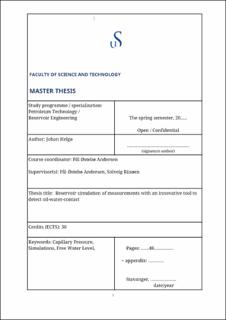| dc.description.abstract | Hydrotell is developing a tool which will measure the pressure difference between oil phase and water phase in reservoirs with hydraulic conductivity. This pressure difference is then used to locate the free water level (FWL) and the oil-water contact (OWC) can be calculated based on formation properties. Oil and water will have different densities and different pressure gradients. At any point in the reservoir, the difference between these two gradients can be used to calculate the distance down to where the difference is zero, and by definition, the location of FWL.
The OWC is one of the most important parameters for estimating hydrocarbon resources in a reservoir and is usually only known at the start of production. During production, the OWC level is in constant change and its exact position at all times in different parts of the reservoir is unknown. As such, continuous update on the FWL and thus a better estimate of the OWC will have immense value for operators as 1) Planning new wells can be optimized and wells which would quickly yield unwanted water production can be avoided. 2) Knowledge of FWL enables more precise profit analysis of production. Shut-ins can be planned better as water level approaches the well. 3) After a shut-in of a well because of too high water production, continued surveillance can show how the oil column rebuilds over time. Hydrotells tool can thus help increase efficiency, reduce costs, reduce waste and reduce the amount of new production wells. Reduction of produced water will also reduce waste to sea and reduce cost of cleansing and reinjection.
This thesis aim to explore the relation between pressure readings of the tool and the location of the FWL at dynamic conditions using reservoir simulation. This is achieved by building a not overly complicated yet realistic model where mechanisms can be isolated and changed to observe their effect on pressure readings and FWL during production.
Important questions addressed in the thesis are:
• How is the traditional ‘static’ estimate of FWL influenced by a dynamic setting? Is it influenced by how fast production is happening?
• Can water breakthrough be predicted accurately?
• Is the tool reflecting water traveling through a vertical conduit thief zone (or coning) or the more piston-like zone moving upwards?
• Is there a difference in the estimated FWL if the displacement is more or less piston-like?
• How are pressure readings and FWL estimates influenced by parameters such as porosity, compressibility, saturation functions and driving forces?
It starts by showing that the method used in this thesis to locate the FWL only works if a change in capillary pressure takes place, which is dependent on saturation levels at the sensor. As such, if the transition zone is very small, no change in water level is detected until it is almost at the sensor. Next it finds how smaller saturation changes, such as for viscous fingers and thief zones, is not enough to make an impact on the estimate for the FWL. Also, changing capillary curves yielded inconclusive results which could be of interest for further studies. And lastly it finds how receding water yields conflicting results between the estimate of FWL and the actual water level. | |
